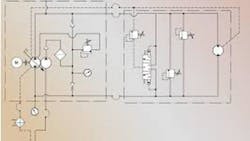Hydrostatic Transmissions: Making Sense Of Case Drain Flow - Part 2
In this previous post on hydrostatic transmissions, I outlined the theory and technique for using case drain flow to determine the condition of a hydrostatic transmission pump and motor. In response to this article, some readers thought that the function of the flushing valve warranted discussion, while others were still confused about the influence of the charge pump when determining case drain leakage. Let's consider flushing valves first.
What is a flushing valve?
A closed-circuit flushing valve (also called a transmission valve or replenishing valve or hot oil purge valve) usually comprises a pilot operated directional control valve and a low pressure relief valve. When the hydrostatic transmission is in neutral, the directional valve is centered and the gallery to the low pressure relief valve is blocked. When the transmission is operated in either forward or reverse, the high pressure side of the transmission loop pilots the directional valve. This opens the low pressure side of the transmission loop to the relief valve gallery.
What does a flushing valve do?
In a closed circuit, fluid from the motor outlet flows directly to the pump inlet. This means that apart from losses through internal leakage, which are made up by the charge pump, the same fluid circulates continuously between pump and motor. If the transmission is heavily loaded, the fluid circulating in the loop can overheat.
The function of the flushing valve is to positively exchange the oil in the transmission loop with that in the reservoir. You can watch a 2-minute simulation video which explains how it does this, here
A flushing valve is most effective when it is located at the motor, assuming the charge check valves are located in the transmission pump, as is the norm. When the hydrostatic transmission is in neutral, the flushing valve has no function and charge pressure is maintained by the charge relief valve in the transmission pump. When the transmission is operated in either forward or reverse, the flushing valve operates so that charge pressure in the low pressure side of the loop is maintained by the relief valve incorporated in the flushing valve. This relief valve is set around 2 bar (30 psi) lower than the charge pump relief valve located in the transmission pump.
The effect of this is that cool oil drawn from the reservoir by the charge pump, charges the low pressure side of the loop through the check valve located close to the transmission pump inlet. The volume of hot oil leaving the motor outlet, that is not required to maintain charge pressure in the low pressure side of the loop, vents across the flushing valve relief into the case of the motor and back to tank, usually via the pump case.
How does a flushing valve influence the process of using case drain leakage to determine the condition of a hydrostatic transmission?
The technique is the same as that outlined in my previous post. As explained above, if a flushing valve is fitted to a transmission, it acts as the charge pump relief valve once the transmission is operated in forward or reverse. So if the flushing valve vents into the case of the motor, then it is possible to determine the condition of the pump by measuring its case drain flow, but not the motor. If the flushing valve vents into the case of pump, then it is possible to determine the condition of the motor by measuring its case drain flow, but not the pump.
This reinforces the point that using case drain flows to determine the condition of the components of a hydrostatic transmission, without a thorough understanding of the circuit in question, can result in incorrect conclusions and the costly change-out of serviceable components. And to discover six other costly mistakes you want to be sure to avoid with your hydraulic equipment, get "Six Costly Mistakes Most Hydraulics Users Make... And How You Can Avoid Them!" available for FREE download here.
About the Author
Brendan Casey Blog
Author
Brendan Casey is a war-weary and battle-scarred veteran of the hydraulics industry. He's the author of The Hydraulic Troubleshooting Handbook, Insider Secrets to Hydraulics, Preventing Hydraulic Failures, The Definitive Guide to Hydraulic Troubleshooting, The Hydraulic Breakdown Prevention Blueprint and co-author of Hydraulics Made Easy and Advanced Hydraulic Control. And when he's not writing about hydraulics or teaching it, Brendan is flat-out helping consulting clients from a diverse range of industries solve their hydraulic problems. To contact him visit his company's Website:
www.HydraulicSupermarket.com

Leaders relevant to this article:
